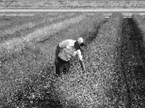EAST LANSING, Mich. — Ensuring the health of cows on dairy farms is one of the producer’s main concerns. Yet, even when cattle health is well-managed – Accidents, metabolic or infectious disease, or calving can cause cows to become non-ambulatory or “down” cows. A down cow is an animal that is unable to stand or walk on her own. Down cows can be costly because they reduce milk production, require extra labor and may have to be euthanized, eliminating even the salvage value. Understanding what causes cows to go down will help farmers develop a treatment plan and do more to prevent it from reoccurring.
Numerous issues can result in down cows. Some of the most prevalent ones are milk fever and dystocia – or difficult calving. During a difficult calving, injuries such as bone fractures, muscle tears, and nerve damage may occur. Some other causes are falling, severe mastitis, ketosis and other metabolic diseases. Identifying the exact issue is important when determining a course of action and a prevention plan.
It is critical to ensure that the cow is not left on concrete when she goes down, as this can cause tissue and muscle damage due to the pressure. It is best to move her to a dry, deep bedded area like a straw pen. Make sure the cow is protected from harsh weather conditions and other cows. Offer feed and water at all times and ensure she is able to access these from where she is laying.
While lateral recumbency, or laying on her side, is common in milk fever cases, rolling her onto her sternum can prevent further issues. Lateral recumbency can cause her to aspirate any regurgitated fluid. Roll the cow to change the side body weight pressure is being applied. This should be done a few times a day. The immense pressure can further injure her leg and tissues if she remains stationary. Imagine the pressure of a cow laying on your leg. How long could the cow be there before causing tissue damage? This is why it is important to roll or move down cows. Cows should be rolled every four to six hours.
Skid steers are one of the best options to move a cow from where she went down to where she will be cared for. To carry a down cow correctly in the bucket of the skid steer or tractor, put the bucket on the ground and slowly move the bucket close to her, but not too close where her skin may be pinched and lacerated. Put a halter on her and tie her head to her back leg on the side her head is turned to. It will often be the leg on top. Use a quick release knot to tie the head to the back leg. Tying the leg will prevent injury for both employee and cow. Roll her into the bucket. Lift the bucket, tip it backwards and cautiously move to the appropriate area. Make sure your bucket is large enough to fit the cow comfortably with no limbs hanging out.
A sled is another great tool in moving down cows. A sled may be placed where she can be rolled onto it, and pulled with a tractor. Ensure all her limbs are on the sled before any movement and her halter is tied to her rear leg. When moving a down cow, it is important to have an adequate number of people. On average, a down cow usually requires three people. One person to drive the tractor or skid steer and the other two to be on the ground rolling and moving the cow with ropes.
As standing on their own may be difficult during recovery, hip lifts may be used only to promote standing. Twice daily, the hip lift may be placed on her hips, and she may be lifted until her feet are still on the ground but bearing little to no weight. Assisting her in rising may allow her to stand on her own again, but she should never be carried or dragged using this method.
Keep a close eye on cows that have recently calved. Appropriately treating and handling down cows can decrease their recovery time, but prevention is the most effective method to avoid these issues.
To help decrease the likelihood of a cow becoming non-ambulatory because of injury, evaluate your facilities. Floors should be evaluated to find slippery areas, loading ramps should be properly designed, and trucks should not be over-loaded.
Non-ambulatory cow care should be clearly outlined in the standard operating procedures (SOPs) for the farm. Any employees who handle down cows should be trained when protocols are new or changed and trained annually on proper care and movement of downed cows. SOPs should be kept in an area that is easy for the employees to find and read.
Training for handling a down animal provides an opportunity to remind employees that good care should be taken for all animals on the farm and to be aware of animals that are having difficulty in standing or are slow to respond. Being prepared for the worst is a function of management, so preparations for down cows should be made on every farm.
If you are interested in having a down cow training program on your farm or have any questions about this topic, contact Marianne Buza, Extension Dairy Educator, at the Huron County Michigan State University Extension Office at 989-269-9949 x 612 or at mbuza@msu.edu.
— Marianne Buza, Michigan State University Extension, Shelby Babisz, MSU Extension Intern




